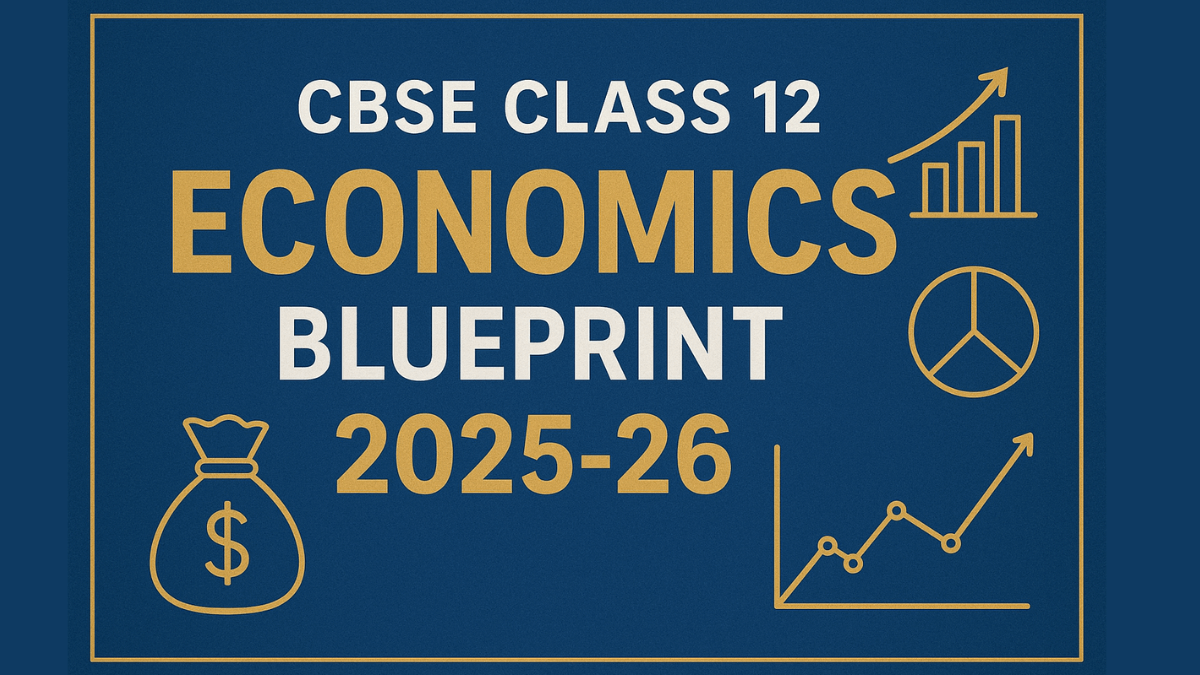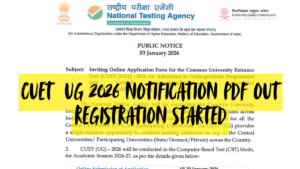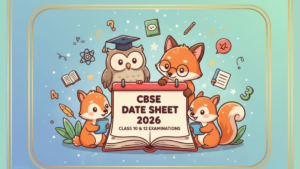The CBSE Class 12 Economics Blueprint 2025-26 will play a major role in your economics subject preparation from the beginning to the end. The CBSE Class 12 Economics curriculum is divided into two sections: Part A (Macroeconomics) and Part B (Indian Economic Development).
The complete 100 marks in the economics allotted to CBSE Class 12 Economics papers are divided into two categories: theory and project. The weightage of the theory paper is 80% and the project work is 20%, respectively. The Economics theory paper will take 3 hours to complete, followed by a 3-hour practical exam. This article has all the chapter-wise marks distribution, blueprint of paper pattern, projects, books, and more.
CBSE Class 12 Economics Blueprint 2025-26
The CBSE Class 12 Economics exam is set for March 2026; therefore, students must be properly prepared using the correct CBSE Class 12 Economics Blueprint 2025-26. Economics is an important subject which covers the chapters like – National Income and Related Aggregates, Determination of Income and Employment, Money and Banking, Government Budget and the Economy, Balance of Payments, Indian Economic Development, Development Experience (1947-90), and Economic Reforms since 1991, Current Challenges facing the Indian Economy and Development Experience of India – A Comparison with Neighbours. With the exam not too far, students should become acquainted with the most recent CBSE Class 12 Economics paper structure and syllabus for 2026.
Blueprint of Class 12 Economics CBSE 2025
The Blueprint of Class 12 Economics CBSE 2025 total of 3 parts according to the latest course structure, stated below:
Marking scheme of Economics Class 12 Chapter Wise –
| Units | Chapters Name | Marks |
| Part A |
Introductory Macroeconomics
|
|
| National Income and Related Aggregates | 10 | |
| Money and Banking | 6 | |
| Determination of Income and Employment | 12 | |
| Government Budget and the Economy | 6 | |
| Balance of Payments | 6 | |
| 40 | ||
| Part B |
Indian Economic Development
|
|
| Development Experience (1947-90) and Economic Reforms since 1991 | 12 | |
| Current Challenges facing Indian Economy | 20 | |
| Development Experience of India – A Comparison with Neighbours | 8 | |
| Theory Paper (40+40 = 80 Marks) | 40 | |
| Total | 80 | |
| Part C | Project Work | 20 |
Weightage of Economics Class 12 2025 Chapter Wise
All detailed unit-wise chapter distribution of all topics of the projects is discussed below. How many classes are ideal to cover each chapter.
Part A: Introductory Macroeconomics
Unit 1: National Income and Related Aggregates (30 Periods)
What is Macroeconomics?
Basic concepts in macroeconomics: consumption goods, capital goods, final goods, intermediate goods; stocks and flows; gross investment and depreciation.
Circular flow of income (two sector model); Methods of calculating National Income – Value Added or Product method, Expenditure method, Income method.
Aggregates related to National Income:
Gross National Product (GNP), Net National Product (NNP), Gross Domestic Product (GDP) and Net Domestic Product (NDP) – at market price, at factor cost; Real and Nominal GDP
GDP Deflator, GDP and Welfare”
“Unit 2: Money and Banking (15 Periods)
Money – meaning and functions, supply of money – Currency held by the public and net demand deposits held by commercial banks.
Money creation by the commercial banking system.
Central bank and its functions (example of the Reserve Bank of India): Bank of issue, Govt. Bank, Banker’s Bank, Control of Credit through Bank Rate, Cash Reserve Ratio (CRR), Statutory Liquidity Ratio (SLR), Repo Rate and Reverse Repo Rate, Open Market Operations, and Margin requirement.”
“Unit 3: Determination of Income and Employment (30 Periods)
Aggregate demand and its components.
Propensity to consume and propensity to save (average and marginal). Short-run equilibrium output; investment multiplier and its mechanism. Meaning of full employment and involuntary unemployment.
Problems of excess demand and deficient demand; measures to correct them – changes in government spending, taxes and money supply.”
“Unit 4: Government Budget and the Economy (17 Periods)
Government budget – meaning, objectives and components. Classification of receipts – revenue receipts and capital receipts;
Classification of expenditure – revenue expenditure and capital expenditure. Balanced, Surplus and Deficit Budget – measures of government deficit.”
“Unit 5: Balance of Payments (18 Periods)
Balance of payments account – meaning and components; Balance of payments – Surplus and Deficit
Foreign exchange rate – meaning of fixed and flexible rates and managed floating. Determination of exchange rate in a free market, Merits and demerits of flexible and fixed exchange rate.
Managed Floating exchange rate system”
Part B: Indian Economic Development
“Unit 6: Development Experience (1947-90) and Economic Reforms since 1991: (28 Periods)
A brief introduction of the state of Indian economy on the eve of independence. Indian economic system and common goals of Five Year Plans.
Main features, problems and policies of agriculture (institutional aspects and new agricultural
strategy), industry (IPR 1956; SSI – role & importance) and foreign trade.
Economic Reforms since 1991:
Features and appraisals of liberalisation, globalisation and privatisation (LPG policy); Concepts of demonetization and GST”
“Unit 7: Current challenges facing Indian Economy (60 Periods)
Human Capital Formation: How people become resource; Role of human capital in economic development; Growth of Education Sector in India
Rural development: Key issues – credit and marketing – role of cooperatives; agricultural diversification; alternative farming – organic farming
Employment: Growth and changes in work force participation rate in formal and informal sectors; problems and policies
Sustainable Economic Development: Meaning, Effects of Economic Development on Resources and Environment, including global warming”
“Unit 8: Development Experience of India: (12 Periods)
A comparison with neighbours India and Pakistan
India and China
Issues: economic growth, population, sectoral development and other Human Development Indicators”
Part C: Project in Economics (20 Periods)
| Class 12 Economics Projects | |||
| · Micro and Small Scale Industries | · Digital India- Step towards the future | · Food Supply Channel in India |
· Rain Water Harvesting – A solution to water crisis
|
| · Contemporary Employment situation in India | · Vertical Farming – An alternate way | · Disinvestment policy of the government |
· Silk Route- Revival of the past
|
| · Goods and Services Tax Act and its Impact on GDP | · Make in India – The way ahead | · Health Expenditure (of any state) |
· Bumper Production- Boon or Bane for the farmer
|
| · Human Development Index | · Rise of Concrete Jungle- Trend Analysis | · Inclusive Growth Strategy |
· Organic Farming – Back to the Nature
|
| · Self-help group | · Aatmanirbhar Bharat | · Trends in Credit availability in India | · e-Rupee (e- ₹) |
| · Monetary Policy Committee and its functions | · Sri Lanka’s Economic Crisis | · Role of RBI in Control of Credit |
· Sustainable Development Goals (SDG’s)
|
| · Government Budget & its Components | · Environmental Crisis | · Trends in budgetary condition of India |
· Comparative Study of Economies (Maximum three economies)
|
| · Exchange Rate determination – Methods and Techniques | · New Education Policy (NEP) 2020: A Promise for a New Education System | · Currency War – reasons and repercussions |
· G-20: Inclusive and Action Oriented
|
| · Livestock – Backbone of Rural India | · Amrit Kaal: Empowered and Inclusive Economy |
· Alternate fuel – types and importance
|
|
| · Sarva Shiksha Abhiyan – Cost Ratio Benefits | · Any other newspaper article and its evaluation on basis of economic principles |
· Golden Quadrilateral- Cost ratio benefit
|
|
| · Minimum Support Prices | · Cashless Economy |
· Relation between Stock Price Index and Economic Health of a Nation
|
|
| · Waste Management in India – Need of the hour | · Any other topic |
· Minimum Wage Rate – Approach and Application
|
|
The markings of the projects will be based on the following 4 aspects –
| S. No. | Heading | Marks Allotted |
| 1 | Relevance of the topic | 3 |
| 2 | Knowledge Content/Research Work | 6 |
| 3 | Presentation Technique | 3 |
| 4 | Viva-voce | 8 |
| Total | 20 Marks |
Cbse class 12 economics blueprint 2026
| SN | Typology of Questions | Marks | Percentage |
| 1 | Remembering and Understanding: Exhibit memory of previously learned material by recalling facts, terms, basic concepts, and answers. Demonstrate understanding of facts and ideas by organizing, comparing, translating, interpreting, giving descriptions, and stating main ideas |
44 | 55% |
| 2 | Applying: Solve problems to new situations by applying acquired knowledge, facts, techniques and rules in a different way. | 18 | 22.50% |
| 3 | Analysing, Evaluating and Creating: Examine and break information into parts by identifying motives or causes. Make inferences and find evidence to support generalizations. Present and defend opinions by making judgments about information, validity of ideas, or quality of work based on a set of criteria. Compile information together in a different way by combining elements in a new pattern or proposing alternative solutions. |
18 | 22.50% |
| Total | 80 | 100% |
Blueprint of Economics Class 12 2025: Books
These are the Prescribed Books that students should follow while completing the Economics syllabus. Students are recommended to regularly follow these books and revise them many times.
- Statistics for Economics, NCERT
- Indian Economic Development, NCERT
- Introductory Microeconomics, NCERT
- Macroeconomics, NCERT
- Supplementary Reading Material in Economics, CBSE
Note: Students can get all these books in Hindi Medium as well.










 CUET UG 2026 Online Registration Started...
CUET UG 2026 Online Registration Started...
 CUET 2026 Free Batches Launched by CUET ...
CUET 2026 Free Batches Launched by CUET ...
 CBSE Date Sheet 2026 for Class 10 & ...
CBSE Date Sheet 2026 for Class 10 & ...







